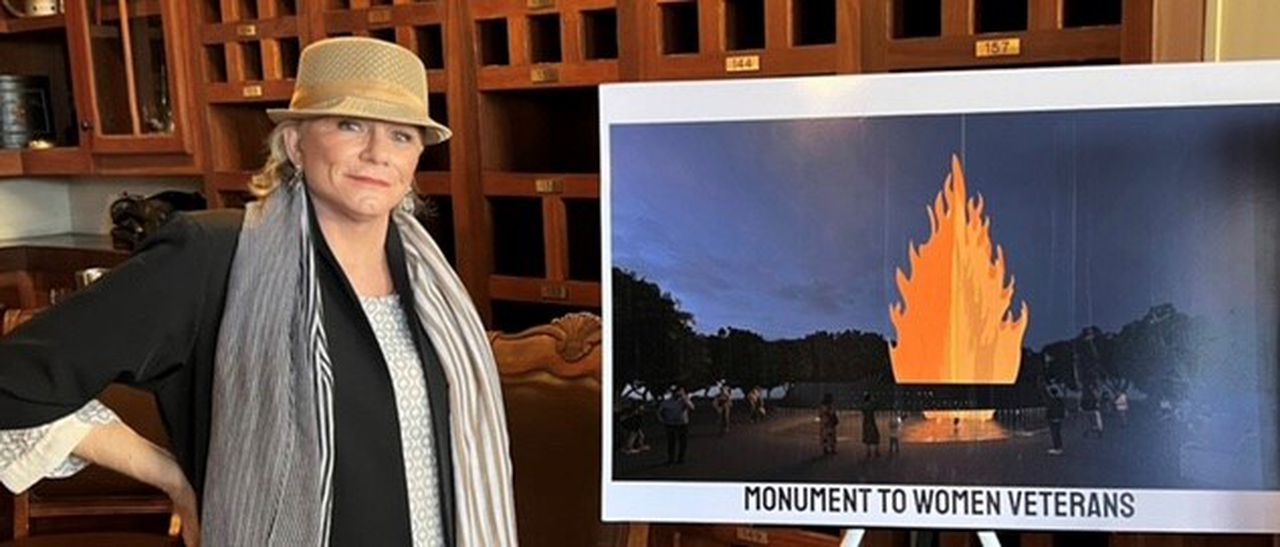Beth Thames: Sculptor wants to honor women veterans
Although she has lived all over the world, internationally-known sculptor Elizabeth MacQueen has come home to Alabama, where her roots are deep. Growing up in Mountain Brook, she heard family tales about her great grandfather, James William Macqueen, president of Sloss Sheffield Steel and Iron Company.
Some were tall tales. It wasn’t true that grandfather fell into a caldron of molten steel while inspecting his product. But it is true, she says, that she has metal in her DNA, an urge to create art using steel and bronze. She’s done that, and carved marble too, for 50 years in nine countries.
And the honors, accolades, and awards have followed. She’s won best of show and best of sculpture for her work in Canada, Europe, and all over this country. Her monuments can be seen in Costa Rica, Italy, Germany, Mexico, and in her home state of Alabama, where her life-size statue of Shakespeare’s character, Puck, stands near the Carolyn Blount Theatre in Montgomery. The piece was commissioned by Red Blount, Postmaster General under President Nixon.
Her “Four Spirits” commemorative bronze piece in Birmingham’s Kelly Ingram National Park is a dramatic testament to the four girls killed in the 16th Street church bombing by the KKK in 1963. A CBS documentary, “Hope and Honor,” aired in 2013, marked the 50th anniversary of the tragedy and features MacQueen’s description of how she made the life size figures and the emotional toll the creation took on her and others involved in the project. The film, available on YouTube, won an Emmy.
MacQueen studied sculpture at UCLA, then completed an independent study program in the international sculpting community in Pietrasanta, Italy, honing her craft.
“It’s not an easy one,” she says. “It’s rough, physically demanding, and sometimes you’re in toxic environments.” To get the work done, especially when she’s on deadline, she has slept in studios, tents, foundries, and once, for four days, in her car. It gave her compassion for the homeless, she says.
Creating life size figures usually takes many months. “Kind of like having a baby,” she says. With some of her projects, the temperature of the metal when it is poured is 2200 F. The air is full of particles. She wears protective gear.
One frequent theme in MacQueen’s work is honoring ordinary people. She created the first monuments to female athletes—who are often overlooked—for the Women’s Basketball Hall of Fame. Called “The Past, Present, and Future,” it stands 32 feet tall. Her “Cannery Lady” was the first monument to non-military women who worked in factories when men left the country to fight in the war. “The Chinese Pioneers” was first to honor the Chinese workers who built the transcontinental railroad.
And her sculpture “Those Who Wait” is a memorial to the women whose family members were lost at sea. It stands in California’s Morro Bay National Park.
MacQueen is proud that her work has mattered, and she hopes it has elevated the mind and the heart in this “troubled and disturbed world,” as she calls it. Her next project will be “Women Are the Light,” a tribute to female veterans. She plans a 35-foot stainless steel wall featuring a fountain and flames. There are over two million female veterans. She thinks they should be recognized.
As MacQueen settles into life back home in Alabama, she wants to bring more global artists to this high-tech town.
Local business leaders and art patrons encouraged MacQueen to move to Huntsville from Mexico, where she and adult daughter had been living. One of them, Michael Kirkpatrick, believes that STEM towns—places built on science, technology, engineering, and mathematics, can benefit from promoting the arts as well.
“STEM cities can become STEAM cities,” he says, “adding the arts to what we offer.”
MacQueen will soon open her “Art Works in Progress” gallery. People who want to see what she offers can call for an appointment at 850-293-8854 or visit her website at macqueenfineart.com.
